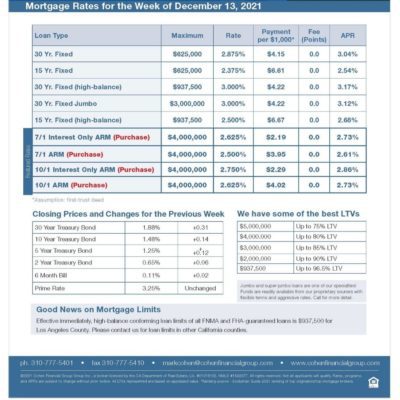Investor concerns about the negative impact of the omicron variant on economic growth eased modestly this week, which was good for stocks
but unfavorable for mortgage rates. The latest inflation data came in right on target and caused little reaction. Mortgage rates ended last week a little higher.
Core CPI Jumps Again in November
The Consumer Price Index (CPI) is a closely watched inflation indicator that looks at price changes for a broad range of goods and services. Core CPI excludes the volatile food and energy components and provides a clearer picture of the longer-term trend. In November, Core CPI was 4.9% higher than a year ago, up from an annual rate of increase of 4.6% last month, and the highest level since 1991.
There are many reasons why the annual core inflation rate has jumped from the readings below 2.0% seen earlier in the year, including a tight labor market, strong consumer demand for goods, rising energy prices, and supply chain disruptions. Shortages for many items have caused enormous cost increases, such as used cars prices which are 31% higher than a year ago. Fed officials and economists are divided about to what degree the recent spike in inflation is due to temporary factors caused by the pandemic or are more structural (long-lasting) in nature.
As incoming data has tilted more toward the latter case, investors have pulled forward the expected timeline for Fed rate hikes, and the first is anticipated to take place around May of next year.
Job Openings Hit Near-Record Highs
The JOLTS report measures job openings and labor turnover rates, and the latest data indicated that the labor market remains very tight. At the end of October, there were a massive 11 million job openings, close to the recent record high, and about 4 million more than in January 2020 prior to the pandemic. A high level of job openings reflects a strong labor market, as companies struggle to hire enough workers with the necessary skills. A very large number of employees also willingly left their jobs in October. This is viewed as a sign of labor market strength as well, since people usually quit
only if they expect that they can find better jobs.
The Department of Labor releases the total number of new claims for unemployment insurance each week, and the latest reading was just 184,000. This was the lowest level since 1969 and down from elevated figures in the millions seen last spring during the partial shutdown of the economy.
Major Economic News Due This Week
Looking ahead, investors will closely follow news on the omicron variant. Beyond that, the next Fed meeting will take place on December 15, and investors will look for additional guidance on the pace for tapering bond purchases and the timing for future rate hikes. Retail Sales also will be released on Wednesday. Since consumer spending accounts for over two-thirds of U.S. economic activity, the retail sales data is a key indicator of growth. Housing Starts will come out on Thursday. The next European Central Bank meeting also will take place on Thursday.

mortgage rates week of 12-13-21
